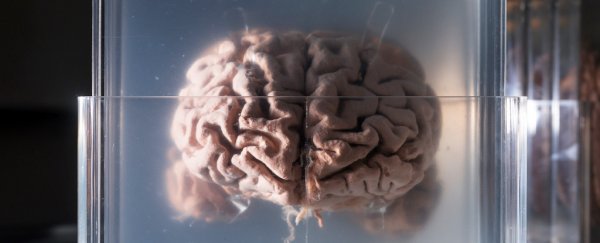Human brains are some of the biggest in nature, but it's not altogether clear why that is. A pair of studies are now suggesting a new hypothesis – that a family of genes responsible for building up brain matter has given our endocranial volume (ECV) a boost.
Crucially, these genes are exclusively active in humans. They're not found at all in macaque monkeys or orangutans, the researchers report, and they're present but inactive in gorillas and chimpanzees - the primates we share much of our genome with.
The genes, named NOTCH2NL, work by delaying the development of cortical stem cells into neurons, producing more neurons as a result. They were found to be abundantly expressed in the neural stem cells of the cerebral cortex.
 Neanderthal (left) and human (right) brains. (Fiddes et al)
Neanderthal (left) and human (right) brains. (Fiddes et al)
"One of the holy grails of researchers like us is to find out what during human development and evolution is responsible for a bigger brain, particularly the cerebral cortex," says one of the team, developmental biologist Pierre Vanderhaeghen from the Université Libre de Bruxelles (ULB) in Belgium.
"Given the relatively fast evolution of the human brain, it is tempting to speculate that newly evolved, human-specific genes may help shape our brain in a species-specific way."
And of course over the last several million years, that brain-shaping has gone on to help us think, solve problems, and develop our culture on another level to the rest of the animal kingdom.
Vanderhaeghen and his team came up with a new way of analysing the body's RNA, which is essential to the coding and expression of genes – this helped the researchers identify the genes in the cerebral cortex that were specific to humans.
With the closely linked NOTCH2 ancestral gene already known to control the path of cortical stem cells towards making neurons or making more stem cells, they focussed in on NOTCH2NL.
After a series of tests on mice embryos and lab tests on human pluripotent cells, the special powers of these genes were finally discovered.
"From one stem cell, you can either regenerate two progenitor cells, generate two neurons, or generate one progenitor stem cell and one neuron," explains Vanderhaeghen.
"And what NOTCH2NL does is bias that decision in a slight way towards regenerating progenitors, which can later go on to make more neurons. It's a small early effect with large late consequences, as often happens with evolution."
A separate team of scientists was led to NOTCH2NL through a study of genes expressed in brain development in humans and macaque monkeys – one of the key differences they came across was the absence of NOTCH2NL in the monkeys.
By deleting NOTCH2NL from human stem cells in the lab, the researchers noticed stem cells differentiating faster into neurons, but depleting the stem cell pool overall at the same time – so the resulting patch of cortex tissue is smaller.
Adding to the evidence that NOTCH2NL genes are responsible for brain size, the team was able to correctly re-map their location on the genome for the first time, since the previous mapping turned out to be wrong.
Variations at a region known as 1q21.1 – associated with several neurodevelopmental disorders such as ADHD – were linked to smaller or larger brains.
In other words, the researchers say, NOTCH2NL seems to be something of an evolutionary trade-off between larger brains and susceptibility to conditions like macrocephaly and microcephaly, where the head is either abnormally big or abnormally small.
It's too early to close the case on our bigger brains yet though – for starters, we don't yet know much about the mechanism that NOTCH2NL genes are using. The researchers behind these two studies also want to look at a greater sample of patients and lab models over a longer period of time to examine what's happening more closely.
What makes the findings even more fascinating, however, is that this Notch signalling pathway is one of the oldest developmental pathways we know about, and it's in almost every animal – and yet we humans have somehow developed the very recent NOTCH2NL variation to boost our grey matter.
"Our brains got three times as big primarily through the expansion of certain functional areas of the cerebral cortex, and that has to be a fundamental substrate for us becoming human," says one of the researchers who worked on the second study, bioinformatician David Haussler from the University of California, Santa Cruz.
"There's really no more exciting scientific question that I can think of than discovering and decoding the mysterious genetic changes that made us who we are."
